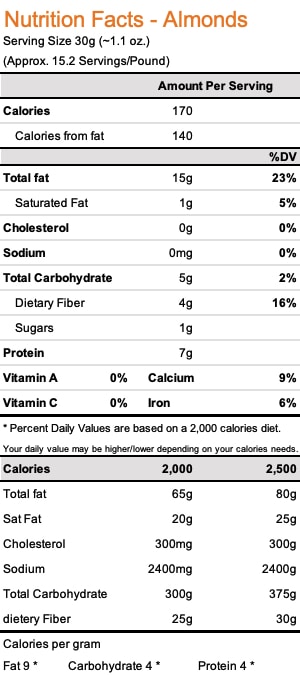Almonds
Almonds
USA, Australia, Spain, Italy
The almond is a small, deciduous tree, which thrives best in a Mediterranean climate with warm, dry summers and mild, wet winters. They can grow to an average height of 4 to 10 meters, and the trunk can get up to 30 cm in diameter. The young, green twigs turn purplish once they are exposed to sunlight, and in its second year, they turn greyish. The tree blooms profusely in early spring when it has no leaves yet, and the flower is white to pale pink and contains a large amount of nectar. The tree can bear fruit from its third year, but it will be at full production around the 7th or 8th year, up to 25 years.
The tree forms drupes, in which an almond develops. It has an outer hull and a hard, woody shell around the seed (the almond). About 20% of the flowers provide a nut. This depends mostly on the weather conditions, as well as the availability of bees, diseases and the health of the tree. The almond is not self-pollinating, which is why farmers use bees for pollination on a large scale. Fewer bees also mean fewer almonds, but one tree will produce approximately 15 to 20 pounds of almonds.
Seven to eight months after flowering, the drupes burst open as the almonds are ripe and ready to harvest. Two weeks prior to harvest, the farmers stop watering the trees. By shaking the tree, the drupes fall on the ground, where they are left to dry to bring the moisture in the shell down from 10 to 12% to 5%. After 5 to 6 days, the drupes are picked up, and the watering starts again to avoid drying out the trees.
The USA (especially California) produces around 80% of the world production of almonds. Because the USA was unable to keep up with global demand due to serious drought between 2003 and 2013, Australia became the number two almond producers. Within Europe, Spain and Italy are mostly responsible for almond production.
Almonds are sold shelled or unshelled and blanched, which means the almonds have been treated with hot water to soften the seed coat, which is then removed to reveal the white embryo. There are sweet and bitter almonds. The sweet ones are used in various foods, such as almond milk, nougat and almond oil. The bitter almond is less produced; it contains 2-3% of the hydrocyanic acid glycoside amygdalin. Bitter almonds are mainly used to enhance the aroma of sweet almonds in, for example, marzipan.
More information can be found on our Cornhouse Nuts News page.





 Westplein 58
Westplein 58



 We use cookies to ensure you get the best experience on our website. For more information, please read our
We use cookies to ensure you get the best experience on our website. For more information, please read our